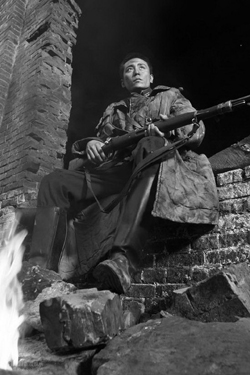At the time the Japanese army entered Nanjing in 1937, Hamburg-born John Rabe had already been in China for thirty years. A prominent member of the expatriate community, he was managing director of Siemens China and the leader of the Nanjing branch of the Nazi Party. His swastika armband helped him communicate with the Japanese military, soon to become Germany's ally, and enabled him, with the help of other foreigners, to establish an "International Safety Zone" that helped save the lives of over 200,000 Chinese civilians. Rabe also opened up his own home to about 650 refugees.
|

|
|
A shocking scene from Lu Chuan's "City of Life and Death": Chinese people are buried alive. [China.org.cn]
|
After his death in 1950, his diary entries remained a secret until the 1990s when historian Iris Chang contacted Rabe's granddaughter Ursula Reinhardt when she was collecting documents for her book The Rape of Nanking.
On February 28, 1938 Rabe was ordered home by the German government. This is a point repeatedly stressed in Lu Chuan's movie: Rabe left China at the time when Chinese people were still suffering great hardship. In "City of Life and Death", Rabe seems helpless, in contrast to his courageous and selfless image in the John Rabe biopic. Rabe's role is downplayed by Lu who wants to present his own interpretation of history; that the Chinese people fought back on their own, and that while foreigners helped, they were not Messiahs.
|

|
|
A helpless Chinese soldier, played by actor Liu Ye, stares at his enemy in Lu Chuan's "City of Life and Death". [China.org.cn]
|
"I respect John Rabe, but I hate it when people make him look like a savior of the Chinese people. It is a violation of the memories of the Chinese public," Lu Chuan said in a recent interview.
Lu Chuan's portrayal of John Rabe caused Tang Daoluan, a professor at Nanjing University and the curator of the "John Rabe and International Safety Zone Memorial Hall", to walk out of a screening, accusing Lu of distorting history, especially with his suggestion that the idea for a safety zone was initially proposed by a Chinese professor, not Rabe.
"Furthermore, in 'City of Life and Death', Rabe's secretary Mr. Tang is based on the real-life figure Han Xianglin, who was not the traitor portrayed in the film, but helped Rabe save the lives of countless Chinese people," Tang Daoluan said. "Denying and downplaying Rabe's contribution is unfair to Rabe, to history, and to the cause of international humanitarianism, and it makes us look like an ungrateful people."
But making a movie is an art form and is all about telling a story based on history to communicate the filmmaker's message. Both films about the city of sorrow are powerful works – so powerful and emotional in fact, that they made many viewers weep in the dark.
Lu Chuan chose to use black-and-white cinematography to recreate the most tragic scenes, avoiding the color of too much blood which would surely have made audiences uncomfortable. He studied volumes of diaries and documents, many from overseas, in an attempt to make his film as true to life as possible. But the first thought in his mind was that he didn't want to do a Chinese version of "Schindler's List".